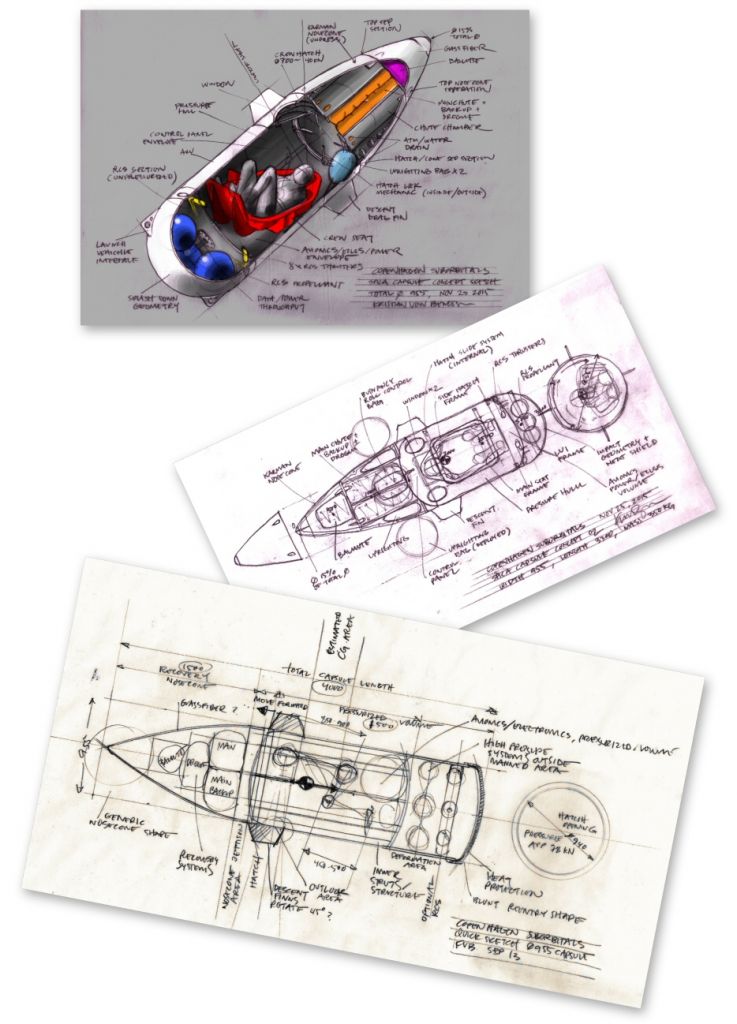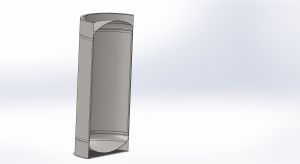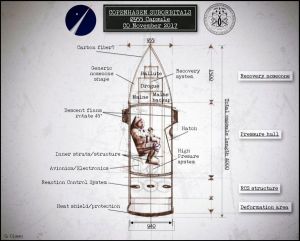Dear readers
For a while now it has been very quiet from us when it comes to the progress of the capsule that is going to bring our astronaut into outer space. The reason for this is a lack of human resources for designing and developing the capsule.
We are trying to change that by gathering a small group of people who will have the capsule design as their primary focus. This means that we are beginning to transform some of the early sketches and models into something more tangible.

Fig. 1: Here are some of the first drawings of a design of the capsule for the Spica rocket made by
Kristian Von Bengtson
When designing a space capsule that is both safe, lightweight and actually possible for us to build, it is important to break the capsule down in sub-systems. This makes it possible to maintain the overall picture of what needs to be designed and in what order, and what influence the different systems have on each other.
Off course it is fun to go into solution mode and start detail design of little bits and pieces like safety harness mounting brackets or cup holders, but you need to maintain a view of the big picture. This is why we start by collecting all the data and results from all the work that has been done on the Spica rocket capsule these past couple of years.

Fig. 2: A more detailed view on how the capsule might end up looking. Graphics: Carsten Brandt
We have previously worked on small scale models in free fall tests and have also had some students from the Technical University of Denmark (DTU) do a project on the ingress / egress hatch. Now we are starting full scale models.
The first will be a so called boiler plate model of the pressure hull made in steel. This is to use the same model for several tasks. It is being used to determine the location of systems that has to do with the astronaut. That would be things like seat design and –placement, hatch size and –placement, porthole size and –placement etc. Another thing that we can use a sturdy and rigid enough model to do drop tests, to evaluate different deformation structures. These will reduce the shock effect on the astronaut when the capsule has the splashdown when landing.

Fig. 3: This is a cross section of the boiler plate model, which we are going to weld together. Graphics.:
Martin Petersen
We are working on a budget and purchasing the materials for the capsule so we can begin building something tangible, so expect some small updates and pictures of the production of the model here on the site and on social media in the coming time.
When we are a bit further in the design process we will begin to add more of the identified systems to the boiler plate model. Here there is another advantage of using steel: it is easy to weld on and cut off new things.
It is still a bit to early to talk about the different systems. We will share that when we are a little further ahead
Ad astra
Martin H. Petersen, CS Capsule Lead

Fig.4: Kapsel grafik. Illustr.: Carsten Olsen.




13 Comments
jim popwell · 13th December 2017 at 4:15 pm
what is the expected G-Load profile on the person during launch and reentry.
Thomas Pedersen · 10th January 2018 at 10:18 pm
G-load increases to about 5G at MECO. Then it’s smooth sailing to apogee and until the capsule takes on the thicker atmosphere where it will shortly peak at around 5Gs again.
Niels Foldager · 10th January 2018 at 10:29 pm
Around 3 G during launch. Up to 4 G during re-entry. We don’t know the exact figures until further design and experiments are completed.
Niels Foldager · 10th January 2018 at 10:33 pm
The figures that Thomas provides may be those we end up with.
dman · 15th December 2017 at 5:08 pm
Will the astronaut be wearing a pressure suit in case of cabin pressure failure?
Thomas Pedersen · 10th January 2018 at 10:21 pm
This is still under debate, so there is no final answer yet. Making a pressure suit is no easy task and it can introduce failure modes in itself. So the question is really if wearing a pressure suit increases or decreases overall mission succes probability?
Bernhard · 9th January 2018 at 6:17 pm
The sitting position makes me wonder if the acceleration will drain blood from the astronauts brain and rupture blood vessles in her legs? Will she pass out? Will he wear compression gown to keep the blood flow normal? Did/will you make centrifuge experiments or will you rely on existing results?
Thomas Pedersen · 10th January 2018 at 10:23 pm
The G-load will slowly increase to 5Gs from launch to MECO, thus the time above 3G is 15 sec or so. Most healthy persons should be able to withstand that.
David Mužný · 10th January 2018 at 11:19 am
I really like your project, I would like to help you as a volunteer. I’m a mechanical engineer
with interest in aerospace engineering and spacecraft. Just a pity I’m from a distance, but I’d like to help.
Thomas Pedersen · 10th January 2018 at 10:25 pm
David, while it is difficult to take directly part from a distance, you can help us spread the word and gain more supporters for financial backup! And if you are ever in the Copenhagen area let us know and we arrange a visit 🙂
Jirka · 18th May 2018 at 12:53 pm
Are you not planning to have a launch escape system?
Thomas Pedersen · 21st May 2018 at 11:10 pm
Not really. It adds too much mass and while it mitigates some problems it creates a whole set of new problems. I don’t think we can create a system where the overall “sum of safety” is higher than without a LES.
Cop Sub News – Space Today · 13th December 2017 at 1:14 pm
[…] https://copenhagensuborbitals.com/enclosure-for-the-astronaut […]
Comments are closed.